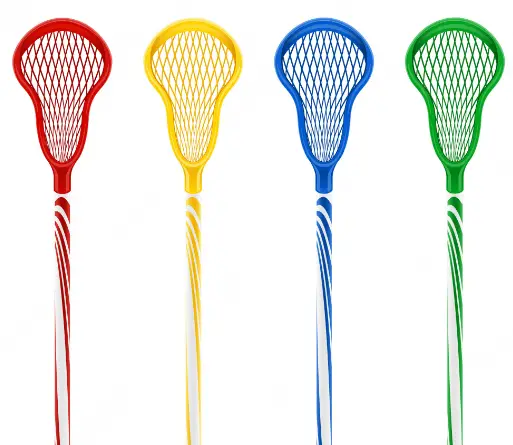The lacrosse stick, also known as the crosse, is an essential piece of equipment for any lacrosse player. It is used to handle, pass, and shoot the ball in the game. The lacrosse stick is made up of several components including the head, shaft, and pocket. These components work together to allow players to have the precision and control they need to succeed on the field.
In this article, we will take a closer look at the lacrosse stick and its various parts, as well as the different types of sticks available to players. Whether you’re a beginner or a seasoned veteran, understanding the lacrosse stick is crucial to improving your game. So let’s dive in and explore the world of the lacrosse stick.
The History Of Lacrosse Stick
Of course, lacrosse has a long history and was first played by tribes as a way to please the Creator. The original sticks resembled enormous hickory spoons with animal-product netting and leather knots.
In the nineteenth century, colonists from Europe took up the sport. After Canadian dentist William George Beers standardized the game’s rules, lacrosse gained the most popularity in Canada, where it eventually became the country’s national sport in the 1860s.
The materials for lacrosse sticks remained largely unchanged until the 1970s when an innovation era that took advantage of contemporary advancements in engineering and understanding of kinematics began. However, the shape of the stick changed as the sport spread to clubs and universities in the United States.
Until the 1970s, when an innovation era that took advantage of contemporary advancements in engineering and understanding of kinematics began, the materials of the stick stayed mostly unchanged even if the design of the stick changed as the sport gained popularity.
Plastic Head
In August 1970, STX created the first plastic head. This was the first time a lacrosse stick had been split in two and a plastic head had been attached to a hardwood shaft. Lefties and righties may use the same stick because the head was symmetrical.
Aluminum Shaft
The invention of the aluminum shaft occurred at the same time as improvements in hockey stick design in the early 1980s. The reduced weight of hollow aluminum shafts compared to wood allowed for faster stick speed, shots, and passes.
Synthetic Mesh
The material that makes up the pocket started to transition from conventional leather to synthetic mesh in the 1980s. Mesh was lighter, performed better, and was more resilient in harsh weather.
Titanium Shaft
Dave Morrow, an All-American defenseman at Princeton whose father ran a Detroit metal tubing company, began using a titanium handle in 1992. It did not dent or snap as easily as aluminum. After the creation of Warrior Lacrosse, titanium quickly became the norm.
The Modern Lacrosse Stick
The modern lacrosse stick is a piece of equipment used in the sport of lacrosse. It is used by players to catch, carry, and throw the lacrosse ball. The stick consists of a shaft, made of either wood, aluminum, or composite materials, with a plastic or nylon head attached to one end. The head of the stick is shaped like a pocket and is used to hold the lacrosse ball. The pocket is formed by a set of nylon or leather strings that are woven through holes in the head of the stick. The strings are tensioned to create a pocket that is deep enough to hold the ball securely, but not so deep that it is difficult to throw or catch the ball. Some recent advancements such as mesh and semi-hard heads have also been introduced in lacrosse sticks.
Parts Of A Lacrosse Stick
- Head: The head of a lacrosse stick is the section where the ball is caught, passed, and shot. It is typically made of plastic or composite material and has a pocket where the ball sits.
- Shaft: The shaft is the main body of the lacrosse stick and is usually made of aluminum, composite, or wood. It is what players hold onto when they play.
- Throat: The throat of a lacrosse stick is the area where the head and shaft connect. It is often reinforced with additional material to provide additional strength.
- Pocket: The pocket is the area in the head of the lacrosse stick where the ball sits. It is made of mesh or string and is designed to hold the ball securely while allowing for easy movement.
- Butt end: The butt end of a lacrosse stick is the bottom portion of the shaft and is used to control the ball and make passes. It is often capped with a rubber or plastic end cap.
- Strings: The strings of a lacrosse stick are used to create the pocket and control the ball. They are typically made of nylon or other synthetic materials and are woven in a specific pattern to create the pocket.
- Sidewalls: The sidewalls are the vertical sections of the head of the lacrosse stick that support the pocket and the ball. They are usually made of plastic or composite material.
- Scoop: The scoop is the curved shape of the head of the lacrosse stick that allows players to pick up and scoop the ball easily. It is typically made of plastic or composite material.
- End cap: The end cap is the rubber or plastic cap that covers the bottom of the shaft and is used to control the ball and make passes.
Conclusion
In conclusion, the lacrosse stick is a crucial piece of equipment for any lacrosse player. It is essential to understand the different types of sticks available and the key components that make them different. The head, shaft, and pocket are all important factors to consider when choosing a lacrosse stick. Proper maintenance and care can also help prolong the life of a lacrosse stick and ensure that it performs at its best on the field. Overall, the lacrosse stick is an essential tool for any lacrosse player looking to improve their game.







